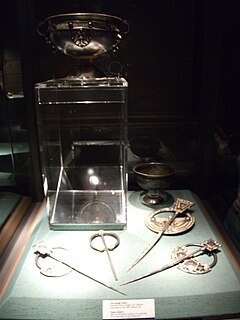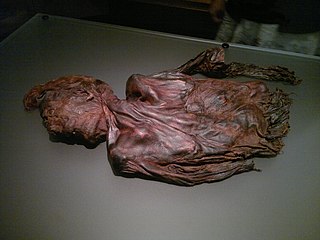 W
WThe National Museum of Ireland is Ireland's leading museum institution, with a strong emphasis on national and some international archaeology, Irish history, Irish art, culture, and natural history. It has three branches in Dublin and one in County Mayo:National Museum of Ireland – Archaeology, Dublin National Museum of Ireland – Decorative Arts and History, Dublin National Museum of Ireland – Country Life, near Castlebar National Museum of Ireland – Natural History, Dublin
 W
WThe National Museum of Ireland – Archaeology is a branch of the National Museum of Ireland located on Kildare Street in Dublin, Ireland, and dealing with Irish and other antiquities. In general, the museum covers the history of Ireland from the Stone Age to the Late Middle Ages. Many important artefacts from the museum were featured in The Irish Times feature and book A History of Ireland in 100 Objects.
 W
WThe National Museum of Ireland - Decorative Arts & History is a branch of the National Museum of Ireland located at the former Collins Barracks in the Arbour Hill area of Dublin, Ireland.
 W
WThe Ardagh Hoard, best known for the Ardagh Chalice, is a hoard of metalwork from the 8th and 9th centuries. Found in 1868 by 2 young local boys, Jim Quin and Paddy Flanagan, it is now on display in the National Museum of Ireland in Dublin. It consists of the chalice, a much plainer stemmed cup in copper-alloy, and four brooches — three elaborate pseudo-penannular ones, and one a true pennanular brooch of the thistle type; this is the latest object in the hoard, and suggests it may have been deposited around 900 AD.
 W
WThe Ballinderry Sword is an iron Viking-style weapon found in a bog on the site of a crannog in Ballinderry, in Rosemount, County Westmeath, Ireland in 1928. It is no. 36 in A History of Ireland in 100 Objects. It was found along with other Viking objects: a longbow, two spearheads, an axe head and a gaming board. The settlement dates from between the late 9th and early 11th century and the collection of artifacts uncovered appears to fit the profile of a wealthy Irish farmer or of a local ruler.
 W
WThe Broighter Gold or more correctly, the Broighter Hoard, is a hoard of gold artefacts from the Iron Age of the 1st century BC that were found in 1896 by Tom Nicholl and James Morrow on farmland near Limavady, in the north of Ireland. The hoard includes a 7-inch-long (18 cm) gold boat, a gold torc and bowl and some other jewellery. A design from the hoard has been used as an image on the 1996 issue of the Northern Ireland British one-pound coins and the gold ship featured in a design on the last Irish commemorative one-pound coins. The Broighter Collar and Broighter Ship also featured on definitive postage stamps of Ireland from 1990–1995. The National Museum of Ireland, who now hold the hoard, describe the torc as the "finest example of Irish La Tène goldworking". Replicas of the collection are kept at the Ulster Museum in Belfast.
 W
WClonycavan Man is the name given to a well-preserved Iron Age bog body found in Clonycavan, Ballivor, County Meath, Ireland in March 2003. The body shows signs of having been murdered. Theories around the meanings and manner of his death vary.
 W
WThe Cross of Cong is an early 12th-century Irish Christian ornamented cusped processional cross, which was, as an inscription says, made for Tairrdelbach Ua Conchobair, King of Connacht and High King of Ireland to donate to the Cathedral church of the period that was located at Tuam, County Galway, Ireland. The cross was subsequently moved to Cong Abbey at Cong, County Mayo, from which it takes its name. It was designed to be placed on top of a staff and is also a reliquary, designed to hold a purported piece of the True Cross. This gave it additional importance as an object of reverence and was undoubtedly the reason for the object's elaborate beauty.
 W
WThe Derrynaflan Chalice is an 8th- or 9th-century chalice, that was found as part of the Derrynaflan Hoard of five liturgical vessels. The discovery was made on 17 February 1980 near Killenaule, County Tipperary in Ireland. According to art historian Michael Ryan the hoard "represents the most complex and sumptuous expression of the ecclesiastical art-style of early-medieval Ireland as we know it in its eighth- and ninth-century maturity." The area known as Derrynaflan is an island of pastureland surrounded by bogland, which was the site of an early Irish abbey. The chalice was found with a composite silver paten, a hoop that may have been a stand for the paten, a liturgical strainer and a bronze basin inverted over the other objects. The group is among the most important surviving examples of Insular metalwork. It was donated to the Irish State and the items are now on display in the National Museum of Ireland.
 W
WThe Dowris Hoard is the name of an important Bronze Age hoard of over 200 objects found in Dowris, County Offaly, Ireland. Items from the deposit are currently split between two institutions: the National Museum of Ireland in Dublin and the British Museum in London.
 W
WThe Fonthill Vase, also called the Gaignières-Fonthill Vase after François Roger de Gaignières and William Beckford's Fonthill Abbey, is a bluish-white Qingbai Chinese porcelain vase dated to 1300-1340 AD. It is the earliest documented Chinese porcelain object to have reached Europe. The vase was made in Jingdezhen, China, and comes from the final years of Qingbai ware in Jingdezhen before it was replaced by the new blue and white porcelain, which started in earnest after 1320. It is an unusual "experimental" vase with applied relief decoration in the medallions, in the usual monochrome blueish-white Qingbai glaze.
 W
WThe Keshcarrigan Bowl is an Iron Age bronze bowl discovered to the north of Keshcarrigan, county Leitrim, Ireland, in the 19th century. The bowl was found in the waterway between Lough Scur and Lough Marrave. It was perhaps a ceremonial drinking cup. The bowl would have been a prestigious item in 1st century Ireland, the bird-shaped handle outstandingly designed and skillfully executed. The Keshcarrigan Bowl is in the archaeology branch of the National Museum of Ireland.
 W
WThe Mooghaun North Hoard or Great Clare Find is the name of an important Bronze Age hoard found at Mooghaun North, near Newmarket-on-Fergus in County Clare, Ireland. Considered one of the greatest Bronze Age hoards of gold ever found north of the Alps, unfortunately most of the treasure was melted down soon after its discovery. What remains of the hoard is currently split between the National Museum of Ireland in Dublin and the British Museum in London. It is no. 11 in A History of Ireland in 100 Objects.
 W
WOld Croghan Man is a well-preserved Iron Age bog body found in an Irish bog in June 2003. The remains are named after Croghan Hill, north of Daingean, County Offaly, near where the body was found. The find is on display in the National Museum of Ireland in Dublin. Old Croghan Man was found three months after a similar find, dubbed Clonycavan Man, in County Meath.
 W
WThe Tara Brooch is a Celtic brooch of the pseudo-penannular type, made in 650 to 750 AD. It was found in Ireland in 1850, but, despite its name, not at Tara but likely near Bettystown on the coast of County Meath. The name by which it became known was attached to the brooch by the jeweller who purchased it, as a marketing ploy for the copies they made. The brooch was exhibited internationally and was one of the artifacts that fuelled the Celtic Revival in the mid-19th century. It is now on display in the National Museum of Ireland in Dublin.